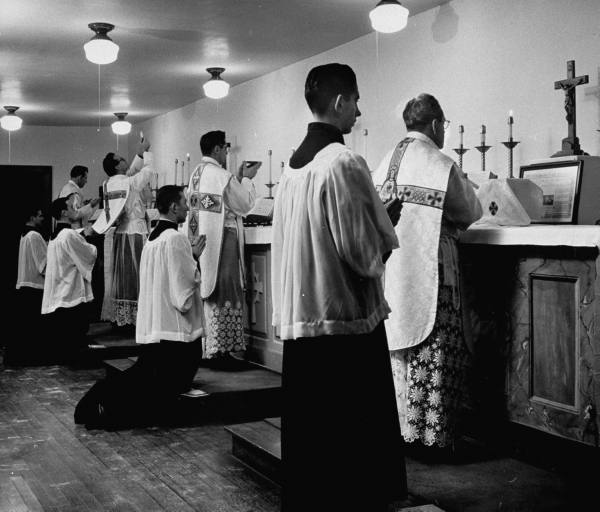 I recently got a question from a reader:
I recently got a question from a reader:
Last week you dealt with a question concerning the “traditional” Latin Mass and by way of contrast the Latin Mass as celebrated in the ordinary form of the new mass. My concern is how to properly participate in this form of the mass in order please God and gain the spiritual benefits of the mass. For instance there are long silent passages in the traditional low mass. Should I purchase a missal in order to best join with the celebrant or are their other ways in which I can participate? Please clarify. Thank you.
There is in fact a very different sense of participation when the Older (Extraordinary) Form of the Latin Mass is celebrated. As you note the Mass is celebrated in such a way that there are long passages that the priest whispers in Latin. Even if one might be able to learn and follow the Latin prayers such a remoteness is startling to many who have not known liturgy to be celebrated in this manner. I will explain in a moment how one can participate in such a situation but at first it might be good to explain why there is such a pronounced silence at Latin Masses.
Historically the whispered Eucharistic prayer (or Canon) developed in monastic settings where it was not uncommon for more than one liturgy to be celebrated at the same time at various side altars. In those days priests did not concelebrate masses as they do frequently today. Each priest had to celebrate his own mass. In monasteries where numerous priest might be in residence, numerous liturgies might be celebrated at similar times. In order not to interrupt each other, the priests conducted these liturgies with a server quietly. This practice continued into modern times (see the picture above right). Over time this monastic silence came to be regarded as a sacred silence. The whispering of the prayers was considered a sign of the sacredness of the words which “should not” be loudly proclaimed. (There are other more complicated theological trends that swept the liturgy too complicated to go into here that also influenced the move to a more silent liturgy) At any rate, the practice of a sacred silence came to be the norm eventually even in parish churches. Hence the hushed tones were not an attempt to ignore the faithful who attended or make their participation difficult but it was associated with a holy silence. People knelt, praying as the priest prayed prayed on their behalf. In the past century as literacy increased among the lay faithful it became more common to provide them with books that contained the texts of the liturgy and those who could read were encouraged to follow along closely. Through the 1940s and 50s these books (called “missals”) became quite common among the laity. By the 1950s there were also some experiments with allowing the priest to have a microphone or to raise the level of his voice so the faithful could follow more easily. These “dialogue Masses” were more popular in some place than others. Sacred silence was still valued by many and adjusting to a different experience was not always embraced with the same fervor, it varied from place to place.

Very good! When I was explaining the silence of the Mass to someone once, I mentioned that the silence makes sense if you consider the solemn Mass as the model, because the choir is singing most of the time.
I Love the Latin mass. People say to me all the time, Your church is boring and “Old Fashion” I would tell them, That’s the delightful quality of my faith. The silence I love, the unknown gives the you “Wonder and Awe” the spiritual singing and ambiance just takes you there. Ummm something I must seek.